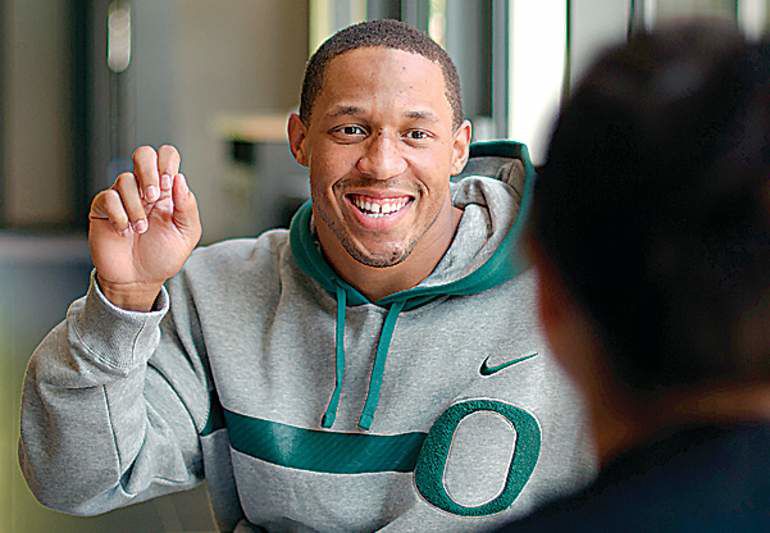Players learn the oops in the Ducks’ ‘O’
Published 4:00 am Friday, November 18, 2011

- Dewitt Stuckey, a senior linebacker, practices signing after class at the University of Oregon. Twenty-nine players are enrolled in the university’s American Sign Language program, which some players find engaging and intuitive since they use signing systems on the field.
EUGENE — When University of Oregon football fans cheer their team, they often hold out their hands in the shape of the letter “O,” for Oregon.
If this makes some Ducks players blush, it is because many of them chose sign language to fulfill their foreign language requirement, and in sign language, the fans are saying — screaming, really — the word vagina. Twenty-nine players on the team are enrolled in the university’s American Sign Language program. Their teacher delights in telling them the true meaning of the sign when they form a spade with their hands.
“I did the ‘O’ once, and I never did it again,” said LaMichael James, the team’s star running back, who recently injured his right elbow. While talking, James spoke quietly so that others would not hear. He would not make the sign. His elbow hurt, he demurred.
Older players recommended the sign language course, players said, because they found it engaging and intuitive — they had grown up using signing systems on the field. A few players said sign language was a welcome alternative to Spanish, which had been a struggle in high school.
“A lot of people stereotype us and think we’re just sitting around and not doing anything,” said Dewitt Stuckey, a senior linebacker and second-year sign language student. “But in this class you have to pay attention. If not, you get completely lost.”
Stuckey, who said he wants to be a counselor at a junior college, signed as he spoke. “It’s kind of rude for us not to sign when we talk,” he explained, motioning across the room to his teacher, Valentino Vasquez, who is deaf.
In the first-year classroom next door, about half the students were football players. Morning practice had ended at 11:15 a.m. and class started at noon, so many arrived with their hair still wet, carrying to-go containers of burgers and fries.
Standing on a box at the front of the room, their teacher, Johanna Larson, looked the part of an excited conductor. Her parents, who are deaf, had visited the class the day before, and she asked whether the students had ever met a deaf person.
A player raised his hand. “When I was young, I played against a deaf school in basketball,” he said. “The referee couldn’t talk to them. We would stop playing, but they would keep playing a few seconds.”
Another player mentioned Derrick Coleman, a running back at UCLA, who is deaf. In fact, in 2009, Deafdigest.net, an online news source for the deaf community, counted at least 76 deaf and hard-of-hearing students who played in the NCAA. Thirty-nine of them played for Division I teams.
Larson plans to tell her students that Gallaudet, a leading institution for the deaf in Washington, claims to have originated the football huddle. The story goes that on a blustery day in 1894, the team’s star player, Paul Hubbard, suspected that someone on the opposing team could read their signs and was anticipating their plays. Hubbard called for his teammates to form a circle. The huddle, at least in this version of its origin, was born.
Larson talks about football with her students in part because the sport is important in deaf culture, but also because she wants to reach the athletes. She first noticed large numbers of football players four years ago, when sign language was approved for the undergraduate foreign language requirement.
“We suddenly had a huge group of diverse students in our class of 40 students, and I wondered, Is this because, you know the age-old adage, football players take the easiest classes?” she said. “I’ve determined that it’s not.”
Colleagues made similar observations. The graduation rate for Oregon football players is 54 percent, which is on the lower end of colleges in the Pac-12 Conference.
It is not unheard of for college athletes to be fast-tracked through no-show classes. At Auburn, for example, athletes were found in 2004 to be receiving high grades in courses that required no attendance and little work.
Larson said the football players taking sign language at Oregon follow the same grading curve as nonathletes. “Many of them have some sort of innate ability,” she said. “They’ve been watching signals for so long and many of the students on the team are real tactile learners with great peripheral vision.”
For nonathletes in the class, being around players tested them on another level, said Jeanne Jensen, a former sign language student. “A lot of the people in the class grew up around only white people,” she said. “Having athletes in the class shrunk the bridge between football players, who are these borderline celebrities, and your everyday student.”
After two years, Jensen said, there was an unspoken bond between the athletes and nonathletes, partly because after two years everyone could converse in sign language.
For James, sign language has been a way to rib his running backs coach, with whom he is close. “He keeps asking, ‘What are you saying?’” he said.
Others can be kept in the dark, too, which is probably a good thing because, as James learned from his teachers, there is not as much nuance in sign language. “If you’re ugly, you’re ugly,” he said. “There’s no, ‘She’s all right,’ like there is in English.”
Which is why the suggestive spade-shaped “O” is so painfully awkward — to those who know sign language, there is no disguising its meaning. When Larson, a devoted Ducks fan, heard that James avoids making the sign, she was delighted.
“I’m so proud of him,” she said. “We’re trying to spread the word to make the ‘O’ more of a rounded shape.”





